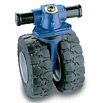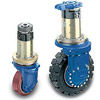Comer Industries
We participate in the global market growth through transforming our products and our organization. We contribute to building a better world as a result of our commitment to sustainable development while protecting the environment. Innovative products, advanced technology and a worldwide presence accounts for our continuous, profitable growth. To foster our business model we both educate and empower new and existing talent.
In a scenario characterized by the recovery of its market sectors of reference, Comer Industries achieved consolidated revenues of 276,534 thousand euros, rising by 14.6% compared to the previous year. Net profit stood at 10,690 thousand euros, an important growth compared to the 2009 fiscal year. The consolidated financial position strengthened, exhibiting a significantnet indebtedness reduction, an increment in equity and a ratio of net financial position to equity (gearing) of 0.35. The number ofemployees also grew from 1,145 to 1,217 (+6.3%).
The company performed very well in the industrial area, particularly in the compact construction and road machinery segments. In the renewable energies sector, Comer Industries further increased its revenues with cutting edge products and technical solutions for new generation wind turbines. The applications for agriculture market also showed signs of recovery, driven by a widespread growth in demand in the second half of 2010.
Comer Production System (CPS)
Comer Industries in 2009 has taken the competitiveness challenge: it has launched a structural improvement program of its industrial activities to achieve world class performance in customer satisfaction (Quality, Cost and Service), safety of workers an...
Read More »
Latest News

Company News
Comer Industries at Windpower USA
Wednesday, June 27, 2012
Comer Industries' products for the wind sector will be on show at Windpower 2012, the wind energy exhibition to be staged at the Georgia World Congress Center of Atlanta (Georgia), USA.
Read More »
View All News »
Product Pages

Electric and Hydraulic Steering Gears
Electric steering gears have been specially studied to be fitted directly to the motor. Hydraulic steering gear is based on the principle of the rack rod that acts on a gear wheel to the axis of which the wheels are coupled.
Read More »

Electric Wheel Drive Units
The gearing transmissions are pre-arranged for the fitting of the electric motor in a vertical position. Developed and designed according to the state-of-the-art technology, they meet all requirements on power transmission of battery-driven industrial trucks.
Read More »

Hydrostatic Transmission Controls
The CVC electronic controller has been designed as control system for hydrostatic tracks vehicles with separate - left and right – hydraulic circuit. The CVC controls in closed loop the displacement of the two pumps, or the speed of the two wheels, to make sure that it corresponds.
Read More »

Orbit Motors
The strength and durability, the compact size and flexibility in the torques allow these orbitmotors to be used in many fields of applications, and generally where low rotation speeds and high torque ratings are required.
Read More »

Axial Piston Motor
Complete range of fixed and variable displacement axial pistons motors, with swashplate system, suitable in open and closed loops. Compact, robust and high- performance motors, durable and easy to maintain.
Read More »

Axial Piston Pump
Complete range of variable displacement axial piston pumps, with swashplate system, for closed loop transmissions. All pumps meet the need for continuously changing speeds, optimise the use of power and torque based on operating requirements, with hydraulic, mechanical, electric and electronic servo controls.
Read More »

Planetary Track and Wheel Drives
The modern and innovative design, the compact construction and the excellent performance characteristics of the PGR/PGW series of gear units make these especially suitable for driving rubber tired or tracked self-propelled vehicles.
Read More »

Planetary Gear Drives
PG planetary gear units are divided into 21 basic groups depending on the different torques that are to be transmitted to the output shaft, which can vary from 0.05 to 65 kNm.
Read More »
View All Product Pages »